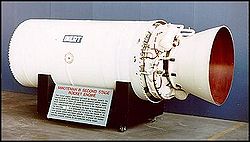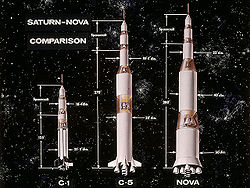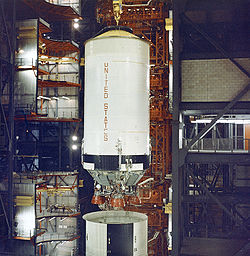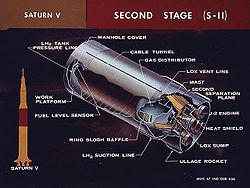
Multistage rocket
Encyclopedia

Rocket
A rocket is a missile, spacecraft, aircraft or other vehicle which obtains thrust from a rocket engine. In all rockets, the exhaust is formed entirely from propellants carried within the rocket before use. Rocket engines work by action and reaction...
that uses
two or more stages, each of which contains its own engines
Rocket engine
A rocket engine, or simply "rocket", is a jet engineRocket Propulsion Elements; 7th edition- chapter 1 that uses only propellant mass for forming its high speed propulsive jet. Rocket engines are reaction engines and obtain thrust in accordance with Newton's third law...
and propellant
Rocket propellant
Rocket propellant is mass that is stored in some form of propellant tank, prior to being used as the propulsive mass that is ejected from a rocket engine in the form of a fluid jet to produce thrust. A fuel propellant is often burned with an oxidizer propellant to produce large volumes of very hot...
. A tandem or serial stage is mounted on top of another stage; a parallel stage is attached alongside another stage. The result is effectively two or more rockets stacked on top of or attached next to each other. Taken together these are sometimes called a launch vehicle
Launch vehicle
In spaceflight, a launch vehicle or carrier rocket is a rocket used to carry a payload from the Earth's surface into outer space. A launch system includes the launch vehicle, the launch pad and other infrastructure....
. Two stage rockets are quite common, but rockets with as many as five separate stages have been successfully launched.
By jettisoning stages when they run out of propellant, the mass of the remaining rocket is decreased. This staging allows the thrust of the remaining stages to more easily accelerate the rocket to its final speed and height.
In serial or tandem staging schemes, the first stage is at the bottom and is usually the largest, the second stage and subsequent upper stages are above it, usually decreasing in size. In parallel staging schemes solid
Solid rocket booster
Solid rocket boosters or Solid Rocket Motors, SRM, are used to provide thrust in spacecraft launches from the launchpad up to burnout of the SRBs. Many launch vehicles include SRBs, including the Ariane 5, Atlas V , and the NASA Space Shuttle...
or liquid
Liquid Rocket Booster
A Liquid Rocket Booster is similar to a solid rocket booster attached to the side of a rocket to give it extra lift at takeoff. A Liquid Rocket Booster has fuel and oxidiser in liquid form, as opposed to a solid rocket or hybrid rocket....
rocket boosters are used to assist with lift-off. These are sometimes referred to as 'stage 0'. In the typical case, the first stage and booster engines fire to propel the entire rocket upwards. When the boosters run out of fuel, they are detached from the rest of the rocket (usually with some kind of small explosive charge) and fall away. The first stage then burns to completion and falls off. This leaves a smaller rocket, with the second stage on the bottom, which then fires. Known in rocketry circles as staging, this process is repeated until the final stage's motor burns to completion.
In some cases with serial staging, the upper stage ignites before the separation- the interstage ring is designed with this in mind, and the thrust is used to help positively separate the two vehicles.
The Taurus rocket is unusual in that its 'stage 1' ignites in flight; this designation is used because its upper three stages are identical to those of the Pegasus rocket, with the 'stage 0' booster replacing the Pegasus' carrier aircraft.
Advantages
The main reason for multi-stage rockets and boosters is that once the fuel is ignited, the space and structure which contained it and the motors themselves are useless and only add weight to the vehicle which slows down its future acceleration. By dropping the stages which are no longer useful, the rocket lightens itself. The thrust of future stages is able to provide more acceleration than if the earlier stage were still attached, or a single, large rocket would be capable of. When a stage drops off, the rest of the rocket is still traveling near the speed that the whole assembly reached at burn-out time. This means that it needs less total fuel to reach a given velocity and/or altitude.A further advantage is that each stage can use a different type of rocket motor each tuned for its particular operating conditions. Thus the lower stage motors are designed for use at atmospheric pressure, while the upper stages can use motors suited to near vacuum conditions. Lower stages tend to require more structure than upper as they need to bear their own weight plus that of the stages above them, optimizing the structure of each stage decreases the weight of the total vehicle and provides further advantage.
Disadvantages



Orbit
In physics, an orbit is the gravitationally curved path of an object around a point in space, for example the orbit of a planet around the center of a star system, such as the Solar System...
had staging of some sort.
In more recent times the usefulness of the technique has come into question due to developments in technology. In the case of the Space Shuttle the costs of space launches appear to be mostly composed of the operational costs of the people involved, as opposed to fuel or equipment. Reducing these costs appears to be the best way to lower the overall launch costs. New technology that is mainly in the theoretical and developmental stages is being looked at to lower the costs of launch vehicles. More information can be found on single stage to orbit designs that do not have separate stages.
Upper stages
The upper stages of space launch vehicles are designed to operate at high altitude, and thus under little or no atmospheric pressure. This allows them to use lower pressure combustion chambers and still obtain near-optimum nozzle expansion ratios with nozzles of reasonable size. In many low pressure liquid rocketLiquid rocket
A liquid-propellant rocket or a liquid rocket is a rocket engine that uses propellants in liquid form. Liquids are desirable because their reasonably high density allows the volume of the propellant tanks to be relatively low, and it is possible to use lightweight pumps to pump the propellant from...
upper stage engines, such as the Aerojet AJ-10
AJ-10
The AJ-10 or AJ10 is a hypergolic rocket engine. It has been used to propel the upper stages of several carrier rockets, including the Delta II and Titan III. It will also be used as the main engine of the Orion Crew Exploration Vehicle for NASA's Project Constellation.It was first used in the Able...
, propellants are pressure fed without need for complex turbomachinery. Low chamber pressures also generate lower heat transfer rates, which allow ablative or radiative cooling of the combustion chambers rather than more elaborate regenerative cooling.
Difference from payload
An upper stage is a mechanism, part of the launch vehicleLaunch vehicle
In spaceflight, a launch vehicle or carrier rocket is a rocket used to carry a payload from the Earth's surface into outer space. A launch system includes the launch vehicle, the launch pad and other infrastructure....
system, that has no other purpose than to lift upwards something else - a spacecraft
Spacecraft
A spacecraft or spaceship is a craft or machine designed for spaceflight. Spacecraft are used for a variety of purposes, including communications, earth observation, meteorology, navigation, planetary exploration and transportation of humans and cargo....
, satellite
Satellite
In the context of spaceflight, a satellite is an object which has been placed into orbit by human endeavour. Such objects are sometimes called artificial satellites to distinguish them from natural satellites such as the Moon....
or another payload. The distinction is not always clear cut. In some cases, for example, the upper stage has other uses after the payload reaches orbit, or a payload has a secondary function of providing some of the impulse required to reach orbit. In such cases, the function of the upper stage and the payload are combined. In some cases a payload, besides its main duties, can perform some propulsion actions on its own (e.g., moving a satellite moving from GTO
Geostationary transfer orbit
A geosynchronous transfer orbit or geostationary transfer orbit is a Hohmann transfer orbit used to reach geosynchronous or geostationary orbit....
to GEO
Geostationary orbit
A geostationary orbit is a geosynchronous orbit directly above the Earth's equator , with a period equal to the Earth's rotational period and an orbital eccentricity of approximately zero. An object in a geostationary orbit appears motionless, at a fixed position in the sky, to ground observers...
). One case of controversial classification is the Polyus weapons platform, which required use of its on-board propulsion to reach orbit
History and development
From an illustration and description in the 14th century ChineseHistory of China
Chinese civilization originated in various regional centers along both the Yellow River and the Yangtze River valleys in the Neolithic era, but the Yellow River is said to be the Cradle of Chinese Civilization. With thousands of years of continuous history, China is one of the world's oldest...
Huolongjing
Huolongjing
The Huolongjing is a 14th century military treatise that was compiled and edited by Jiao Yu and Liu Ji of the early Ming Dynasty in China...
of Jiao Yu
Jiao Yu
Jiao Yu was a Chinese military officer loyal to Zhu Yuanzhang , the founder of the Ming Dynasty . He was entrusted by Emperor Hongwu as a leading artillery officer for the rebel army that overthrew the Mongol Yuan Dynasty, and established the Ming Dynasty...
is the oldest known multistage rocket; this was the 'fire-dragon issuing from the water' (火龙出水, huo long chu shui), used mostly by the Chinese navy. It was a two-stage rocket that had carrier or booster rocket
Booster rocket
A booster rocket is either the first stage of a multi-stage launch vehicle, or else a strap-on rocket used to augment the core launch vehicle's takeoff thrust and payload capability. Boosters are generally necessary to launch spacecraft into Earth orbit or beyond...
s that would eventually burn out, yet before they did they automatically ignited a number of smaller rocket arrows that were shot out of the front end of the missile, which was shaped like a dragon's head with an open mouth. This multi-stage rocket may be considered the ancestor to the modern YingJi-62
C-602
The C-602, also known as YJ-62, is a Chinese subsonic anti-ship missile that can also be used as a land attack cruise missile.C-602 made its public debut in China at the end of 2006 during the 6th Zhuhai Airshow, though the name begun first appear in 2005. The missile is reportedly deployed...
ASCM
Anti-ship missile
Anti-ship missiles are guided missiles that are designed for use against ships and large boats. Most anti-ship missiles are of the sea-skimming type, many use a combination of inertial guidance and radar homing...
. The historian Joseph Needham
Joseph Needham
Noel Joseph Terence Montgomery Needham, CH, FRS, FBA , also known as Li Yuese , was a British scientist, historian and sinologist known for his scientific research and writing on the history of Chinese science. He was elected a fellow of the Royal Society in 1941, and as a fellow of the British...
points out that the written material and depicted illustration of this rocket come from the oldest stratum of the Huolongjing, which can be dated roughly 1300-1350 AD (from the book's part 1, chapter 3, page 23).
The earliest experiments with multistage rockets in Europe were made in 1551 by Austrian Conrad Haas
Conrad Haas
Conrad Haas was a military engineer of the Holy Roman Empire, who is believed to be the first person to describe a multistage rocket in writing.Haas was perhaps born in Dornbach...
(1509–1576), the arsenal master of the town of Hermannstadt, Transylvania
Transylvania
Transylvania is a historical region in the central part of Romania. Bounded on the east and south by the Carpathian mountain range, historical Transylvania extended in the west to the Apuseni Mountains; however, the term sometimes encompasses not only Transylvania proper, but also the historical...
(now Sibiu/Hermannstadt, Romania). This concept was developed independently by at least four individuals:
- the LithuaniaLithuaniaLithuania , officially the Republic of Lithuania is a country in Northern Europe, the biggest of the three Baltic states. It is situated along the southeastern shore of the Baltic Sea, whereby to the west lie Sweden and Denmark...
n Kazimierz SiemienowiczKazimierz SiemienowiczKazimierz Siemienowicz , was a Polish-Lithuanian general of artillery, gunsmith, military engineer, artillery specialist and pioneer of rocketry. Born in the Grand Duchy of Lithuania, he served the armies of the Polish-Lithuanian Commonwealth, a federation of Poland and the Grand Duchy, and in the...
(1600–1651) - the RussiaRussiaRussia or , officially known as both Russia and the Russian Federation , is a country in northern Eurasia. It is a federal semi-presidential republic, comprising 83 federal subjects...
n Konstantin TsiolkovskyKonstantin TsiolkovskyKonstantin Eduardovich Tsiolkovsky was an Imperial Russian and Soviet rocket scientist and pioneer of the astronautic theory. Along with his followers the German Hermann Oberth and the American Robert H. Goddard, he is considered to be one of the founding fathers of rocketry and astronautics...
(1857–1935) - the AmericanUnited StatesThe United States of America is a federal constitutional republic comprising fifty states and a federal district...
Robert Goddard (1882–1945) - the German Hermann OberthHermann OberthHermann Julius Oberth was an Austro-Hungarian-born German physicist and engineer. He is considered one of the founding fathers of rocketry and astronautics.- Early life :...
(1894–1989), born in Hermannstadt, Transylvania
In 1947, Mikhail Tikhonravov developed a theory of parallel stages, which he called "packet rockets". In his scheme, three parallel stages were fired from lift-off, but all three engines were fueled from the outer two stages, until they are empty and could be ejected. This is more efficient than sequential staging, because the second stage engine is never just dead weight. In 1951, Dmitry Okhotsimsky carried out a pioneering engineering study of general sequential and parallel staging, with and without the pumping of fuel between stages. The design of the R-7 Semyorka
R-7 Semyorka
The R-7 was a Soviet missile developed during the Cold War, and the world's first intercontinental ballistic missile. The R-7 made 28 launches between 1957 and 1961, but was never deployed operationally. A derivative, the R-7A, was deployed from 1960 to 1968...
emerged from that study. The trio of rocket engines used in the first stage of the American Atlas I
Atlas I
The Atlas I was an American expendable launch system, used in the 1990s to launch a variety of different satellites. The "I" in "Atlas I" can cause confusion, as all previous Atlas rockets were designated using letters, ending with the Atlas H, however subsequent rockets were designated using roman...
and Atlas II
Atlas II
Atlas II was a member of the Atlas family of launch vehicles, which evolved from the successful Atlas missile program of the 1950s. Atlas II was the last Atlas to use a three engine, "stage-and-a-half" design: two of its three engines were jettisoned during ascent, but its fuel tanks and other...
launch vehicles, arranged in a "row", used parallel staging in a similar way: the outer pair of engines existed as a jettisonable pair which would, after they shut down, drop away with the lowermost outer "skirt" structure of the booster, leaving the central "sustainer" engine to complete the first stage's engine burn towards apogee or orbit.
See also
- Bumper Project
- Saturn VSaturn VThe Saturn V was an American human-rated expendable rocket used by NASA's Apollo and Skylab programs from 1967 until 1973. A multistage liquid-fueled launch vehicle, NASA launched 13 Saturn Vs from the Kennedy Space Center, Florida with no loss of crew or payload...
- NASANASAThe National Aeronautics and Space Administration is the agency of the United States government that is responsible for the nation's civilian space program and for aeronautics and aerospace research...
- Conrad HaasConrad HaasConrad Haas was a military engineer of the Holy Roman Empire, who is believed to be the first person to describe a multistage rocket in writing.Haas was perhaps born in Dornbach...
- Reusable launch systemReusable launch systemA reusable launch system is a launch system which is capable of launching a launch vehicle into space more than once. This contrasts with expendable launch systems, where each launch vehicle is launched once and then discarded.No true orbital reusable launch system is currently in use. The...
- Single-stage-to-orbitSingle-stage-to-orbitA single-stage-to-orbit vehicle reaches orbit from the surface of a body without jettisoning hardware, expending only propellants and fluids. The term usually, but not exclusively, refers to reusable vehicles....

